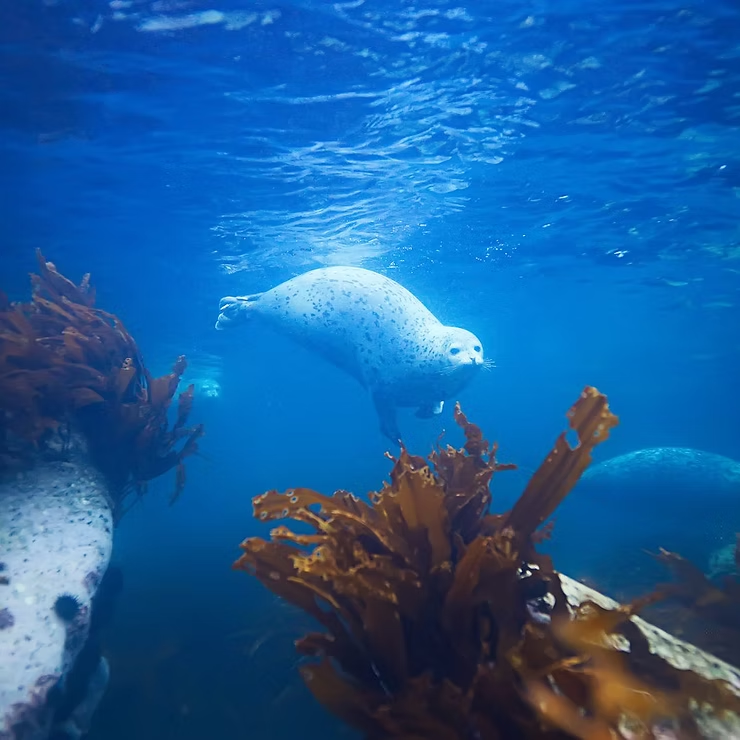Introduction
Life in the ocean is far from easy, yet marine animals have developed an astonishing variety of adaptations that enable them to thrive in environments ranging from shallow reefs to the darkest depths. From camouflage and mimicry to unique respiration strategies and temperature regulation, these creatures demonstrate nature’s ingenuity at its finest. This article explores how marine life has evolved to survive and flourish in diverse and often extreme conditions.
Key Takeaways
- Marine animals use camouflage, mimicry, and sensory adaptations to avoid predators and hunt prey.
- Respiration varies widely, from gill-based breathing in fish to breath-holding in mammals and penguins.
- Temperature regulation is vital, with species adapting to desert heat, polar cold, and shifting sea temperatures.
- Deep-sea species evolve unique traits to withstand pressure, darkness, and limited food sources.
- Microscopic life, such as plankton and tardigrades, plays critical roles in resilience and global ecosystems.
Masters of Disguise
Leafy Sea Dragons
With leaf-like appendages, leafy sea dragons blend into seaweed and kelp forests. Their slow, plant-like movements make them nearly invisible to predators and prey alike. However, they remain vulnerable to habitat loss and pollution, making their survival tied to ecosystem health.
Cuttlefish
Cuttlefish can instantly change their skin color and texture thanks to specialized cells called chromatophores. This allows them to mimic their surroundings, sneak up on prey, and communicate with potential mates. Their camouflage is both a survival tactic and a social tool.
Mimic Octopus
This remarkable cephalopod impersonates more than 15 different species, including venomous lionfish and sea snakes. By transforming its color, shape, and behavior, it avoids predators and outsmarts prey. The mimic octopus shows how survival often depends on adaptability and deception.
Breathing Underwater
African Lungfish
When drought strikes, the African lungfish burrows into mud, encases itself in a mucus cocoon, and survives by breathing air through a snorkel-like passage. This adaptation allows it to endure months or even years without water.
Fish and Marine Mammals
- Fish use gills to extract oxygen directly from water.
- Marine mammals rely on lungs and must surface for air.
- Beaked whales collapse their lungs to avoid decompression sickness.
- Dolphins manage oxygen efficiently, enabling long dives.
Emperor Penguins
These birds store large amounts of oxygen in their muscles, slow their heart rate, and direct oxygen to vital organs during dives. Their adaptations allow them to hunt deep beneath Antarctic ice for extended periods.
Adapting to Temperature Extremes
Saharan Silver Ants
Reflective hairs shield them from desert heat, while lightning-fast movement reduces exposure. By foraging in extreme midday temperatures, they also avoid predators.
Polar Species
Arctic foxes use seasonally changing coats for camouflage and insulation. Antarctic krill produce antifreeze proteins to prevent ice damage in freezing waters. Emperor penguins huddle to conserve warmth, while insects like the mountain stone weta can survive freezing and thawing cycles.
Sea Turtles
Sea turtles regulate body temperature by basking in sunlight or adjusting their swimming depth. However, climate change threatens their survival by altering hatchling sex ratios and food availability.
Life in the Deep
Mariana Snailfish
This species thrives over 8,000 meters below the surface. With translucent bodies and specialized proteins, it withstands crushing pressure and hunts crustaceans in complete darkness.
Deep-Sea Gigantism
Many deep-sea animals grow larger than shallow-water relatives. Size helps conserve energy, adapt to pressure, and store nutrients in food-scarce environments.
Hydrothermal Vent Ecosystems
Life flourishes near scalding vents thanks to bacteria that convert chemicals into energy. Tube worms, shrimp, and other creatures thrive in this extreme, lightless environment, proving life can adapt to seemingly impossible conditions.
Microscopic Marvels
Tardigrades
Also called water bears, tardigrades can survive freezing, radiation, and even the vacuum of space by entering a state called cryptobiosis. Their resilience inspires research into medicine and space exploration.
Plankton
Plankton form the base of marine food webs, supporting everything from small fish to whales. They also absorb carbon dioxide and release oxygen, making them essential to climate regulation.
Bacteriophages
These viruses infect and regulate marine bacteria, supporting nutrient recycling and ocean health. Their role highlights the importance of microscopic organisms in balancing ecosystems.
Predators and Defenses
Sharks
Sharks are apex predators with acute senses, detecting vibrations, electrical fields, and scents from great distances. Conservation efforts are essential to maintain their ecological role.
Venomous Species
Stonefish, eels, and other venomous creatures use toxins as defense and hunting tools. Venom provides a survival edge in ecosystems where competition is fierce.
Conclusion
From the smallest plankton to the most powerful sharks, marine life demonstrates extraordinary strategies for survival. These adaptations—whether camouflage, unique respiration, or pressure resistance—highlight nature’s creativity and resilience. Protecting marine ecosystems ensures that these remarkable species continue to thrive in the face of growing environmental challenges.

